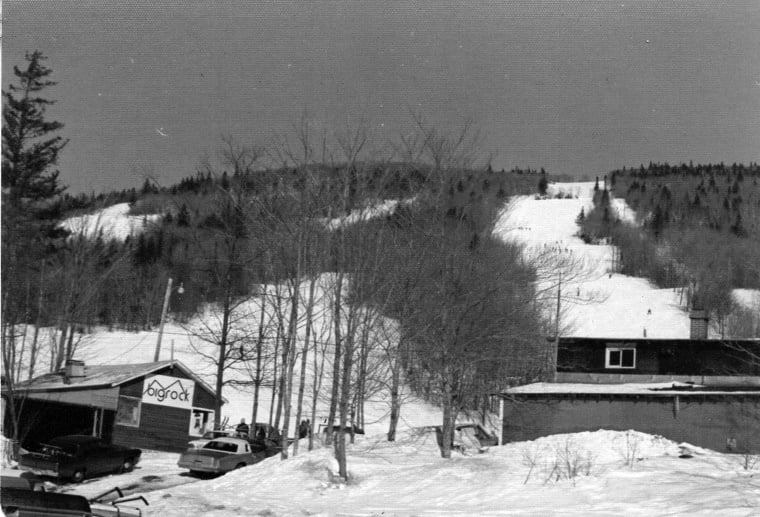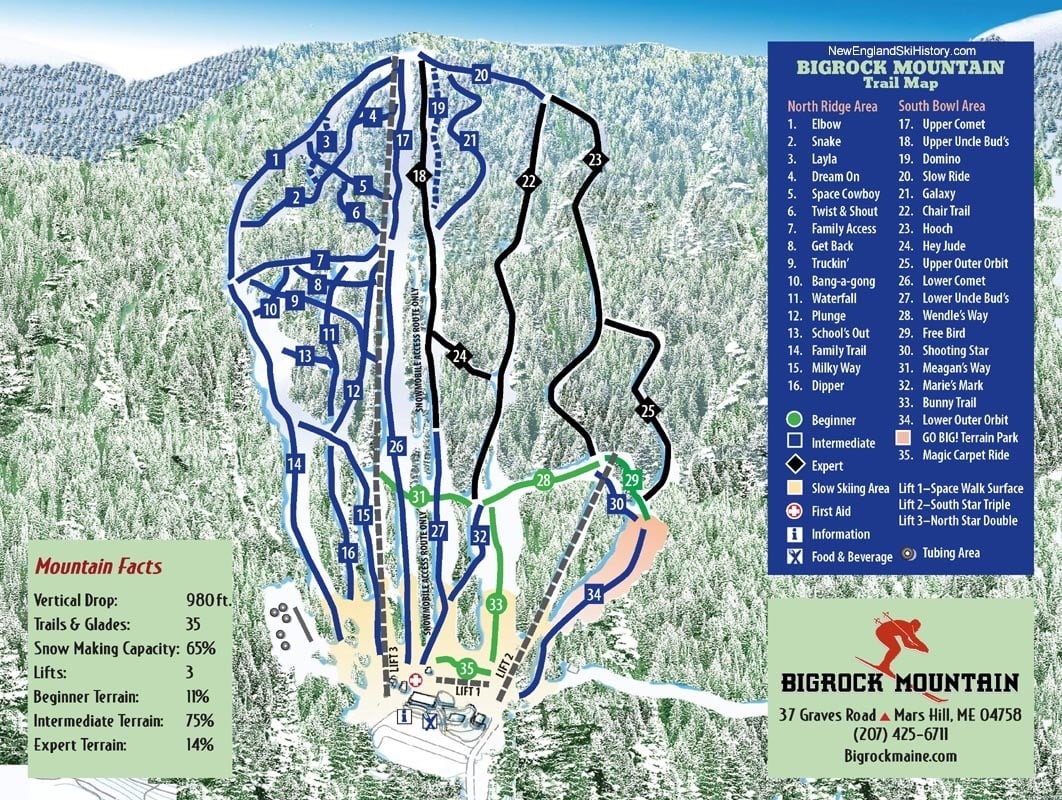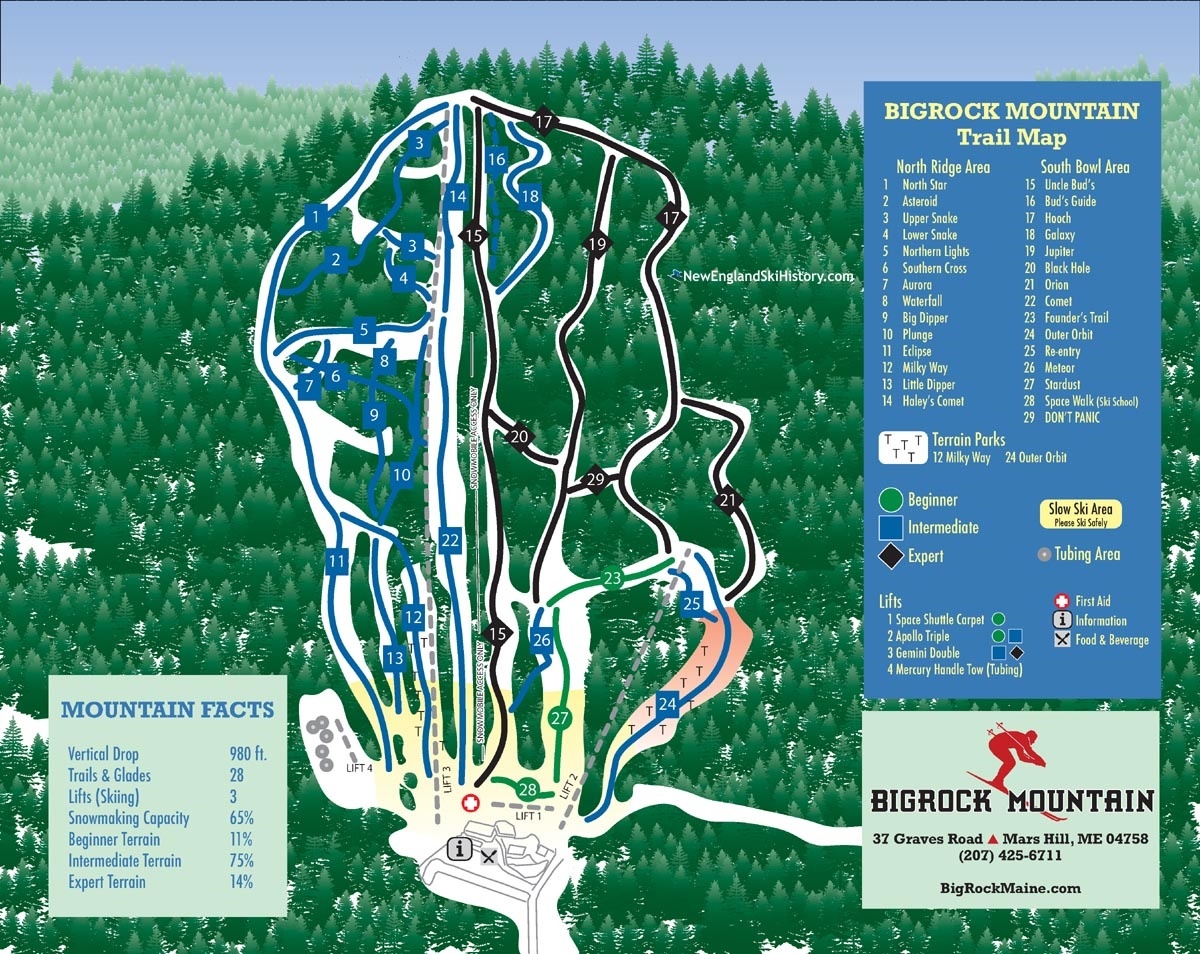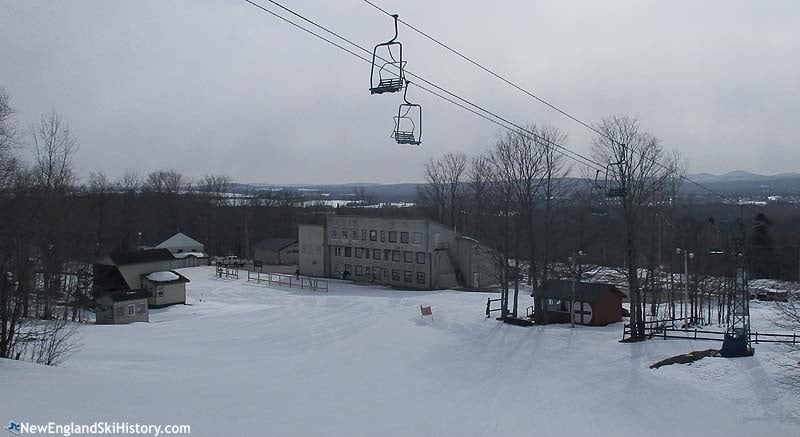CLOSED FOR THE 2024-2025 SEASON
Your cart is currently empty
Big Rock Ski Area is located on Mars Hill Mountain near the Canadian border with New Brunswick. While the mountain is only 1748 feet in elevation it is the highest peak in northeast Maine and home not only to the ski area but the International Appalachian Trail and a large 28 turbine windmill facility. Mars Hill Mountain rises above the gently rolling farmland of Aroostook County. The mountain is a cap of conglomerate rock sitting on limestone. According to town history, the mountain's name comes from an early settler in the area. Canadian Hezekiah Mars traveled up the St. John River and established a camp at the bottom of the mountain. He and his son lived in this area for three years; after they returned to England, the area became known as Mars Hill. In family histories of the mountain have talked about the mountain as a ski hill as early as 1900 when adventurers would climb to the top and ski down but it really did not become a part of modern skiing until 1950.
 |
| View of Mars Hill Mountain from US Route 1. When my children were little they always referred to it as the sleeping elephant. The ski hill is located on the far right of the photo. |
By virtue of its location so close to the northeastern border and the height of the mountain, it is for nearly half of the year is the first place the sun touches the United States. The reason is that as the suns slide northward along the horizon during the warmer months when the North Pole gets sunlight 24 hours a day, the mountain has the advantage over its coastal competitors. So from March 25 to September 13, these dates vary a bit but generally, it is within a few days. There are a few exceptions, even during the comparatively long Mars Hill periods of the year as occasionally the high hills of Carleton County, New Brunswick, block the Mars Hill sunrise for a few minutes, giving the first-morning sunrise to the top of Mount Katahdin.
The question is Mars Hill Mountain in Maine the first place the rising sun touches the continental United States was answered by the planetarium at the University of Maine. Based on their research it was shown that the sun does not rise in the same spot every day, but moves with the seasons between a northeasterly and a southeasterly direction. Mars Hill Mountain is kissed by the sun first from March 25 through September 13. Cadillac Mountain in Acadia National Park gets the first rays of the sun from October 7 through March 6. During the rest of the year–March 7 through March 24 and September 14 through October 6–the sun rises first in Lubec, Maine. The community wanted to capitalize on the event in 1960 when two new states were added, Alaska (49th state) and Hawaii (50th state) with the new fifty-star flag. The Junior Chamber of Commerce built a road to the top of the mountain to flay the flag. The road roughly followed a two and a half-mile downhill trail was cut and cleared for the 1937 Mars Hill Winter Carnival. But building a road was expensive so to raise the money they use all types of events that would be unheard of today.
 |
| The first flyer advertising the mountain used the importance of the first sunrise as part of their promotion. |
They blocked off US Route 1 putting up a tote gate to collect money from all the driver passing the gate under the watchful eye of the state police, they had a jailbird Jamboree where they arrested community VIPs including the police, arrest bus drivers so the passenger would have to bail them out, and they even allowed people to pay to have anyone arrested and jailed where they would have to pay a fine to get out of jail. The road that they constructed was steep and roughly bulldozed reaching the top (much of that original road has been incorporated into various trails.) To get everyone to the top they allowed people to use their own vehicles but the most roads in vehicles that could transport people up the mountain were 4 wheel drive jeeps and trucks because it had been rainy and the road was very muddy. The night before the event it had rained hard making the road even worst. But they managed to get all the people to the top of the mountain including a band, national guardsmen, VIPs, and other interested people. Many people came to the event including a number of people from the local military bases. So on the morning of July 4th, 1960 just before sunrise the cloud broke giving a clear blue sky for the event. At 4:33 am on that day they raised the first fifty start flag as the sun rose above the horizon to a 50-gun salute given by fifty national guardsmen.
The first attempt to create a ski hill was in 1954. It was then that two men tried to build a ski hill on the eastern side of the mountain. Two men, Vaughn Cole (Coles Express Family) and Carol Anderson (a local farmer) put a rope tow up the western side of the mountain. They used a Coles Express truck to run the rope tow by running it around the rear tires. While it had good terrain for all levels of skiers, it just wasn't the right times so it lasted only a couple of years. The fact that it was on a very rough dirt road perhaps did not help make the area a success. Both men went onto other things but Carol Anderson would reappear as the leader of the Red Eagle Ski School for the mountain on the other side of the hill.
 |
| The first Mars Hill Skiway patch circa 1961 |
With the publicity of the Fourth of July celebration for the new flag, it was planned to develop a new ski area on the west side of the mountain that had better access and was closer to the community and rail station. The mountain was developed as a ski hill by the local active Junior Chamber of Commerce to promote the community and called Mars Hill Skiway. A 4000-foot road was constructed giving a vertical rise of 580 feet and several trails were added. A lift was order arrived in New York but they had not panned on shipping costs to get the lift to northern Maine from New York so there it sat for over a month on the dock. The lift was a Poma lift sometimes referred to as a button or platter lift due to the tiny round seat at the end of a pole. It was called a Poma lift derive its name from the leading manufacturer of them, Pomagalski. Often you will hear a Poma lift called a Button lift or platter lift due to the tiny seat that resembles a button. Poma lifts. The lift was essentially a pole with a seat suspended from a set of springs. This pole is connected to a high-level moving cable. The original Poma lift was in the center of the mountain operating until 2005 and finally removed in the summer of 2019. The lift had a capacity of 750 skiers per hour. They finally got the lift installed and operation in March with the grand opening on March 5, 1961. The first full season of operation was the 1961-1962 season when it received national publicity from the New York Times for being the ski area that receives sun rays from the rising sun. A beginner slope was added in the 1966-1967 season serviced by a rope tow.
 |
 |
| Trail Map Circa 1962 | Patch circa 1967 |
It was purchased by Wendell and Marie Pierce and called Ski Way of Aroostook, Inc. which was registered as a Maine corporation in October of 1967, taking over the ski area that year. Over the years the Pierce’s made a number of changes. The rope tow was replaced with a Pony Lift making it easier for beginners. It was in the early years of their operation that the name was changed from Mars Hill Ski Way to Big Rock Mountain. One of the first things that they would do is load up the packer to bring skiers to the top every Sunday.
 |
| Lodge and ticket office circa 1978 |
The top mostly open skiing was popular enough to encourage them to look toward installing a lift to the top of the mountain. In 1978 they installed a 3769-foot Poma lift just to the south of the original Poma lift. This new lift increased the vertical from 580 feet to 980 feet. In 19809 they constructed a new three-floor lodge. It was about this time that the Pierce family started buying another ski area with the eye on expanding Big Rock. They first purchased Burnt Meadow Mountain in western Maine with plans to use the T bar as a lift to the top. Problems with ownership caused them to operate the area for a few years before closing it. The ski area owned the mountain but the community-owned the lift and did not want it to be removed. They moved to the northwest a bit and purchased a lift from Evergreen Valley Ski Area in the 1990-1991 season. In the season of 1993-1994, they installed the 4,616 feet Mueller double chairlift servicing the top of the mountain. The lift is still operating today as it services the top of the mountain. During this period they continued to add trails of various levels of difficulty and constructed a new lodge. While the new lift almost reached 1000 feet vertical it became the northeast most chairlift located in the United States. The chair became known as the North Star Double.
 |
 |
| 2005 Trail Map and trail name before MWSC take over | 2014 Trail Map and Trail names used by MWSC |
After over a quarter of a century of ownership, the Pierces looked to sell Big Rock. In the fall of 2000, Maine Winter Sports Center (MWSC) purchased the 290 acre Big Rock Ski Area, thanks in large part to a $1.5 million grant from the Libra Foundation. They had signed a 99-year lease in 1999 with a small area to the north called Quoggy Jo Ski Area to operate the area and construct a Nordic facility. MWSC immediately started making improvements to the new ski hill included increased parking, a better access road, and several new trails including a new 1.5-mile trail. In the 2002-2003 season, they increased snowmaking capabilities and increased night skiing terrain. In the 2004-2005 season with the aid of $1.2 million from the Libra Foundation, they installed a 1348 foot Doppelmayr triple chairlift called the South Star Triple creating a beginner area with 229 feet of vertical trails. At the same time, they installed a Carpet surface lift to service new skiers in front of the rental shop. At the same time, the Pony lift that had serviced the beginner area was removed. In the 2006-2007 season, they opened a $40,000 tubing park on a 5-acre slope that was served by a Pony Lift. At the top of the mountain, the $55 million Mars Hill Wind Project constructed on the summit ridge of Mars Hill, beginning operation in 2007.
 |
| 2021 Trail Map and Trail names post MWSC |
In June of 2013, the Maine Winter Sports Center announced plans to get out of the alpine ski business. In October it was announced the Big Rock would be closing. The mountain was saved by a group forming a nonprofit with the area being transferred them. With the new owners, there have been improvements to the tubing hill, snowmaking system, and trail improvements.
 |
| The bottom of the mountain as it appears today. |
 |
| Ticket Price History 2000-2021 |